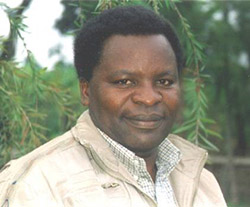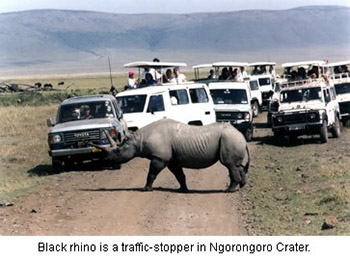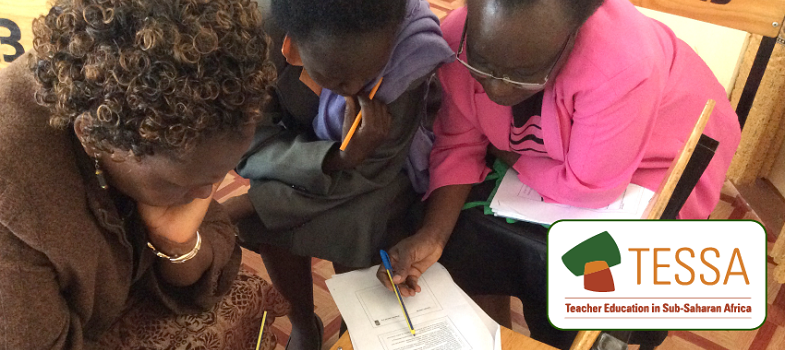Resource 5: Sebastian Chuwa
![]() Teacher resource for planning or adapting to use with pupils
Teacher resource for planning or adapting to use with pupils
Sebastian Chuwa is a man with a vision for his country, his people and the future generations who will inherit their legacy. For 30 years he has been actively studying environmental problems in his east African homeland of Tanzania, and the solutions he has found offer results that benefit not only the land, but all the populations that depend on it for life and sustenance. His methods are based on the two primary objectives of community activism – organising people to address their problems at a local level, and youth education – influencing the teaching of conservation in schools, beginning at the primary level.

He has inspired large groups of community volunteers to come together to solve not only their environmental problems, but problems of poverty alleviation, women’s empowerment and youth employment within the area of Kilimanjaro Region in northern Tanzania. His efforts on behalf of African blackwood have created the first large-scale replanting effort of the species. Because of the establishment of multiple community nurseries and numerous cooperative projects geared towards reforestation over the past decade, in 2004 the ABCP and the youth groups associated with Sebastian’s work celebrated the planting of one million trees. The ever-expanding nature of his work has given him and his community a reputation as leaders in the field of Tanzanian conservation.
History of the African Blackwood Conservation Project
In 1996, James Harris, an ornamental turner from Texas, USA, and Sebastian Chuwa founded the African Blackwood Conservation Project (ABCP), to establish educational and replanting efforts for the botanical species Dalbergia melanoxylon, known as mpingo in its home range of eastern Africa. The wood of mpingo is widely used by African carvers and by European instrument manufacturers for the production of clarinets, flutes, oboes, bagpipes and piccolos. Because of overharvesting and the lack of any efforts directed towards replanting the species, its continued existence is threatened.
In 1995, James Harris, who uses mpingo in his craft, saw The Tree of Music film in the US and determined to do something for the conservation of the species. He made contact with Sebastian by mail and proposed a joint effort: he would launch a fundraising effort among woodworkers, musicians and conservationists of the western world, and send the money to Sebastian to start tree nurseries in Tanzania. The project was enthusiastically endorsed by Mr Chuwa. Since that first contact, the ABCP has become a leading force for mpingo conservation in northern Tanzania, founding nurseries for the production of large numbers of mpingo seedlings and raising awareness about the importance of the species internationally.
Conservation at Ngorongoro

Sebastian Chuwa’s childhood home was on the southern slope of Mt Kilimanjaro at 4,900’ elevation. He learned to love nature at an early age from his father and mentor, Michael Iwaku Chuwa, who was a herbalist. Together they would take long forays into the forests to collect plants for the remedies his father used in his work. On these expeditions over many years he learned the names of the plants and trees of Kilimanjaro’s abundant flora. His love for the natural world continues to this day and is the guiding force behind his work.
After finishing secondary school, he studied at Mweka College of Wildlife Management and after his graduation was hired as a conservator at Ngorongoro Conservation Area. During his 17 years of employment there, he studied and catalogued the plants of the area, discovering four new species (of which two are named in his honour) and assembling a herbarium of 30,000 plants at the visitor’s centre for the use of visitors and staff personnel. Because of his considerable knowledge about the flora of the area, he worked with Mary Leakey at nearby Oldavai Gorge, identifying plants in the area of the Leakey early hominid discoveries. At Ngorongoro, he also instituted a successful protection programme for the endangered black rhinoceros, which was duplicated in other African locales.
Ngorongoro Park is a co-management area where the Maasai communities still live with their cattle herds. During his employment at the park, Sebastian worked closely with the Maasai, studying their medicinal remedies and setting up tree nurseries for their use. He also set up the first youth conservation education programme in Tanzania for Maasai children, focusing on practical activities like establishing tree seedling nurseries and replanting programmes. This club was so successful that it became the blueprint for a nationwide movement, called Malihai Clubs of Tanzania (see below), established in 1985, with offices at NgorongoroPark headquarters in Arusha and now operating nationwide with about 1,000 clubs.
Offices and awards
In 1999, Sebastian was honoured with an appointment as chairman of Kilimanjaro Environmental Conservation Management Trust Fund by the Regional Government Authority of Kilimanjaro Region, Tanzania. This office automatically makes him a member of the Regional Environmental Conservation Committee. His valuable contributions to environmental conservation will be amplified through this position.
Adapted from: http://www.blackwoodconservation.org (Accessed 2008)
Resource 4: Questions concerning use of the land



